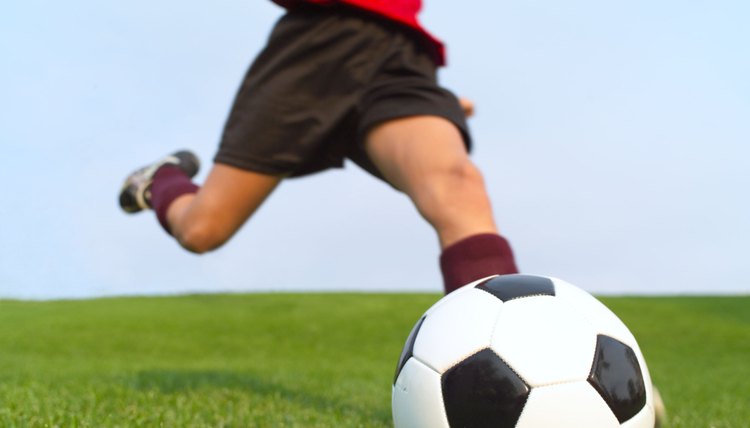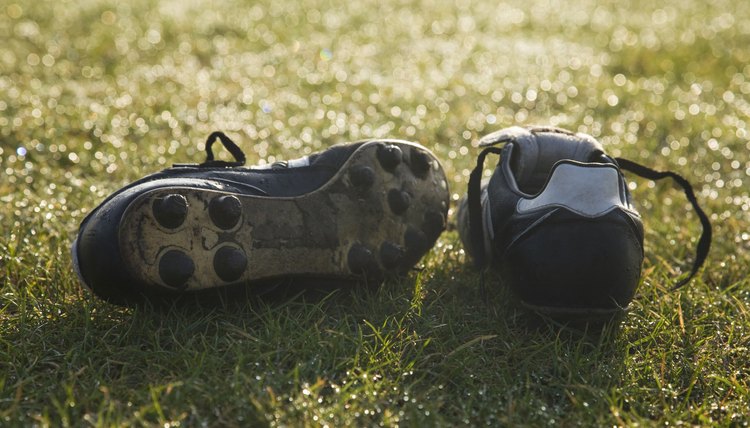The Best Soccer Cleats After an Achilles Injury

Turf shoes may be better than cleats after recovery from Achilles tendon injuries. With their soft nubs, turf shoes spread load on the foot more evenly, maximize flexibility and minimize torqueing during sudden stops. Still, you need to base footwear choices on individual needs and field conditions that may necessitate cleats.
Achilles Tendon Problems

Brand X Pictures/Brand X Pictures/Getty Images
Flexing your foot or standing on tiptoe are actions made possible by the Achilles tendon, which connects the calf muscle to the heel bone. Tendinitis and tendinosis are the two main types of Achilles injuries. The more familiar term, tendinitis, is signaled by swelling of the ankle and refers to an inflammation of the tendon that usually isn't painful. But tendinosis, also called tendinopathy, hurts. The symptoms of tendinosis, which is caused by tears in the tendon, may range from mild ankle stiffness after awakening in the morning to an all-day stiffness and soreness that prevents exercise.
Individual Needs
When ankle and foot pain arise, obtain a medical diagnosis pinpointing the problem and its source. Sports physical therapist Chris Finn, based in North Carolina, says a doctor with sports experience can identify whether a player recovering from Achilles problems will be more likely to avoid future injury by wearing turf shoes that increase range of ankle movement or more rigid, stabilizing cleats. Finn notes that the cause of an Achilles injury doesn't necessarily originate in the tendon but may be created by trouble in another part of the body. Flat feet, caused by fallen arches, are one example. Soccer players with collapsed arches should consider adding orthotic inserts to turf shoes or cleats.
Good Fit
Colorado orthopedic surgeon Waqqar Khan-Farooqi says turf shoes and cleats should provide a glove-like fit. It is important to prevent the foot from sliding around and putting uneven load on the Achilles tendon, Khan-Farooqi observes. Regarding youth players, he warns parents not to purchase shoes that are too big so children can grow into them.
Turf Shoes Vs. Cleats
Khan-Farooqi, who specializes in foot and ankle injuries, says that soccer players who have experienced Achilles injuries may feel more comfortable in turf shoes, because stress on the foot "from traction control and ground contact is spread over a larger area than with the standard rubber or metal spikes." Cleats are more likely to torque the Achilles tendon in a severe, unusual way, because they dig in to the ground.
Sports therapist Finn says that it isn't possible to make blanket statements about what type of soccer shoe is best after Achilles trouble, but that field types need to be considered. Adverse conditions, such as regular muddiness on a natural soccer pitch, may require cleats. A player who is most comfortable in turf shoes may need to compromise and buy cleats that maximize foot movement as well as traction.
Types of Cleats
Soccer players need to consider the kinds of studs or blades that would be most helpful on the soles of their cleats. Cleats with non-removable conical or blade-like, molded studs work well on firm, natural surfaces. Soft or persistently wet fields may necessitate a shoe with few, widely spaced studs that are removable if necessary. Cleats with numerous, short, flat-tipped, non-removable studs are a good choice for hard ground and artificial playing fields. Turf shoes, which have waffle-like soles, also work well on hard and artificial surfaces. In contrast, indoor soccer shoes have no studs or tread.
References
- Chris Finn, PT, CSCS, CGFI; New Kinetic Solutions, LLC; Raleigh-Durham, North Carolina
- Waqqar Khan-Farooqi, MD; Board Certified Orthopaedist; Rocky Mountain Orthopaedic Associates; Grand Junction, Colorado
Writer Bio
Alicia Rudnicki's Library Mix website blends book buzz for all ages. A gardener, she writes for California's Flowers by the Sea nursery. She has a Bachelor of Arts in journalism from UC Berkeley, a Master of Arts in education from CU Denver, and has taught K-12.
